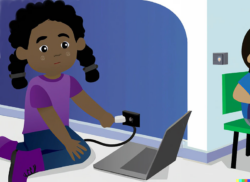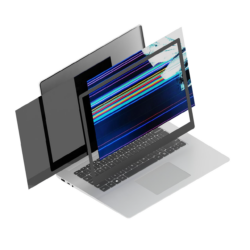The Definitive Guide for K-12 Classroom Device Deployment
Chapter 6: Take-Home Charging Model
 Devices Charged at Home
Devices Charged at Home
Every student is assigned their own device and wall charger. The student is responsible for taking the device back and forth from school, and is expected to charge it to 100% every night. Battery life is expected to last the full school day.
Advantages of the Take-Home Model
● Students have access to a device at home to complete homework assignments.
● If students (or parents) ensure devices are charged every night, districts don’t have to spend budget on or manage charging stations at school.
Disadvantages of the Take-Home Model
● Students don’t consistently bring their devices to school charged, or forget them altogether.
● Damage occurs to student devices while at home and on the way back and forth from school to home.
Considerations about Equity
● Students that are housing insecure or homeless may not have consistent access to electricity to charge their devices at night.
● Some students may not feel safe with an electronic device at home.
● Students may not feel safe transporting a device back and forth from school.
● If the district doesn’t offer assistance for at-home wifi based on need, students may not have home internet access. Great resources:
○ https://www.everyoneon.org/
○ https://digitalbridgek12.org/states/
Parental Considerations
● Some parents don’t want devices at the home for varied reasons, such as limiting screen time or not wanting to be responsible for accidental damage.
Pedagogical Considerations
The debate on how homework impacts learning is still alive and well, with some research finding no impact on improved student performance. Experiential learning happens outside of school hours at home, and some argue is as valuable as time spent in the classroom. When schools or districts go toward no homework, or only reading as homework, there is less need for devices at home.
Equity considerations also come into play when considering pedagogy of homework. Students that have someone to ask questions at home for homework may get more out of it. Some students may not have time for homework because they have other responsibilities at home, such as caring for other siblings or family members.
How Education Systems Respond to Students Forgetting to Charge Devices at Home
● Provide extra power strips in classrooms and a way to borrow chargers.
○ Pros: learning continuity is preserved
○ Cons: can be a fire hazard, tripping hazard, adequate power may not be provided by the circuit, chargers go missing, there aren’t enough wall outlets, students have to move to sit by an outlet, loaning chargers becomes a management program & expense
● Some districts leave it up to each school to create a charger or device loaner program/policy.
● Some schools leave it up to each classroom teacher to train the students on remembering to bring their device charged. (See Appendix A with a longer list of ways classroom teachers try and enforce this).
● Some districts/schools/classrooms have students double up with a neighbor who has a charged device.
● Some districts/schools/classrooms have a “tough love” approach and give the student a paper assignment instead. The idea is the paper
assignment is less interesting than the regular lesson, so hopefully it’s a teaching moment so they don’t forget again.
● Others allow the student to participate in the lesson from their personal device, if they have it.
● For those that have the resources, 2:1 programs are popping up – one device at home and one in the classroom. Devices from previous refresh cycles are often repurposed for these programs.
● Rather than everyone, if certain students have recurring issues, they are issued 2 devices.
● Some schools use central charging towers that allow students to plug in while active on their device. (Requires extra power from circuit).
● Some districts use charging stations where students can charge and store their device when not in use – cafeterias, libraries, locker rooms, atriums, IT
offices, hallways, homerooms, central offices, etc.
How Education Systems Respond to Student Device Damage
 With 1:1 Take-Home there will always be damage to student devices. Everyone in IT involved with a break/fix program is familiar with reasons given for damage- the dog chewed through my cable, it got run over by a teenage sibling, dropped it on the way to school – etc.
With 1:1 Take-Home there will always be damage to student devices. Everyone in IT involved with a break/fix program is familiar with reasons given for damage- the dog chewed through my cable, it got run over by a teenage sibling, dropped it on the way to school – etc.
Even Google for Education recommends purchasing 10% more than enrollment to ensure learning continuity when devices are damaged. Consider creating your own break/fix
program run by students:
● Google for Education: Best Practices for creating a Chromebook Repair Program
● https://edu.google.com/chromebooks/chromebook-repairability/
What repair and loss rates are acceptable?
20-25% repair rates tend to be a good goal. For loss rates, 2-3% is a good goal.
Device Insurance
Many EdTech partners offer insurance, such as IT Saavy’s ChromeCare Warranty.
Leasing Devices
Some districts find that leasing the devices is more cost effect – damages and repairs are built into the leasing fee.
Technology Fees
Some districts implement technology fees for accidental or intentional damage. Fees can vary widely depending on the district, and accidental and intentional damage is often assessed differently. Or, the frequency of damage is assessed differently. There are equity considerations which some districts address by exempting students due to financial need.
● McFarland School District, WI Technology Policy
Bringing 1:1 into the School Building
The surest way to reduce device damage is to keep the devices in school and limit their movement throughout the school building. Based on all the considerations listed in this chapter, that may work for some schools but not others, even within the same district.
Download Complete Playbook